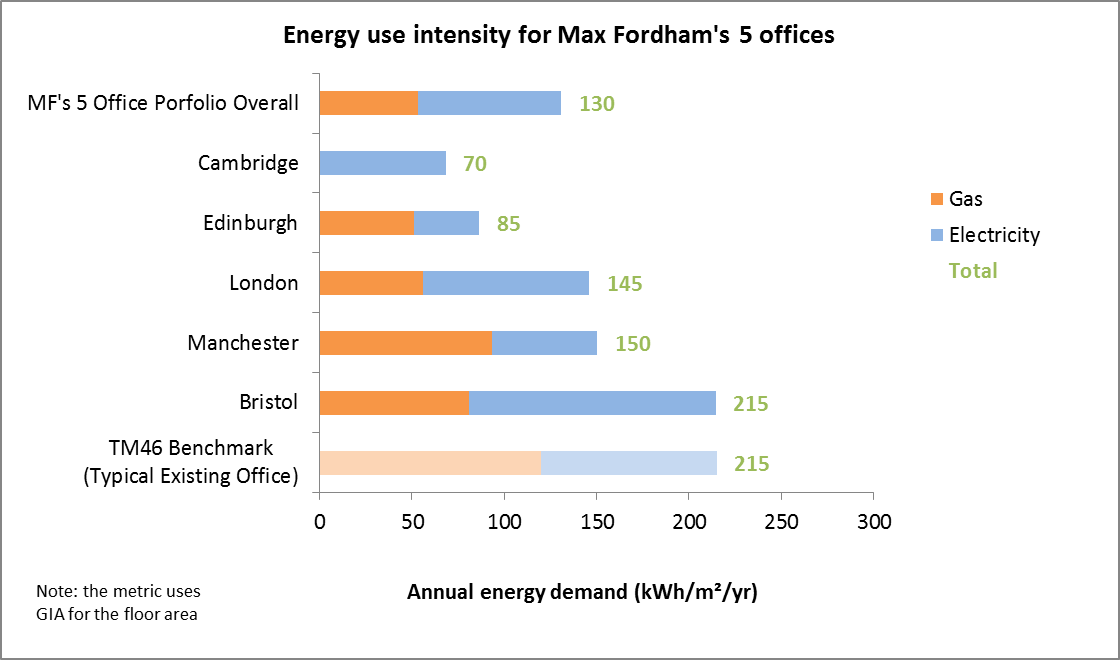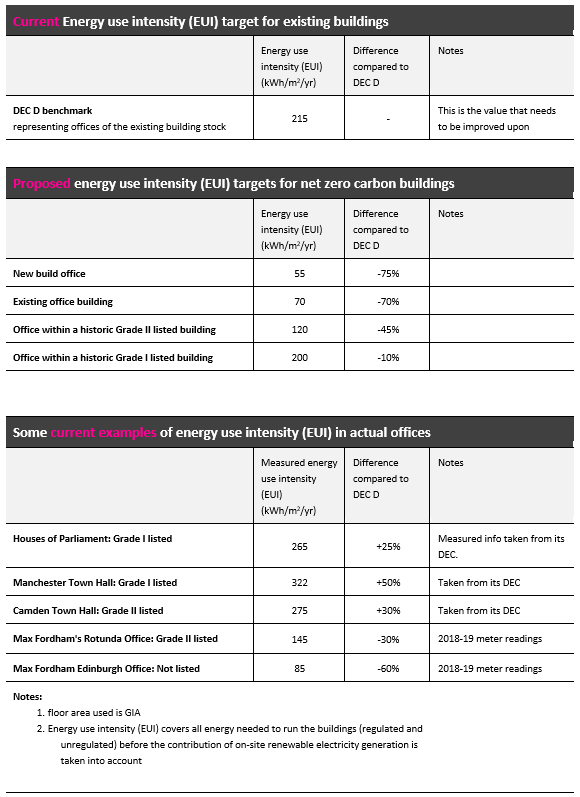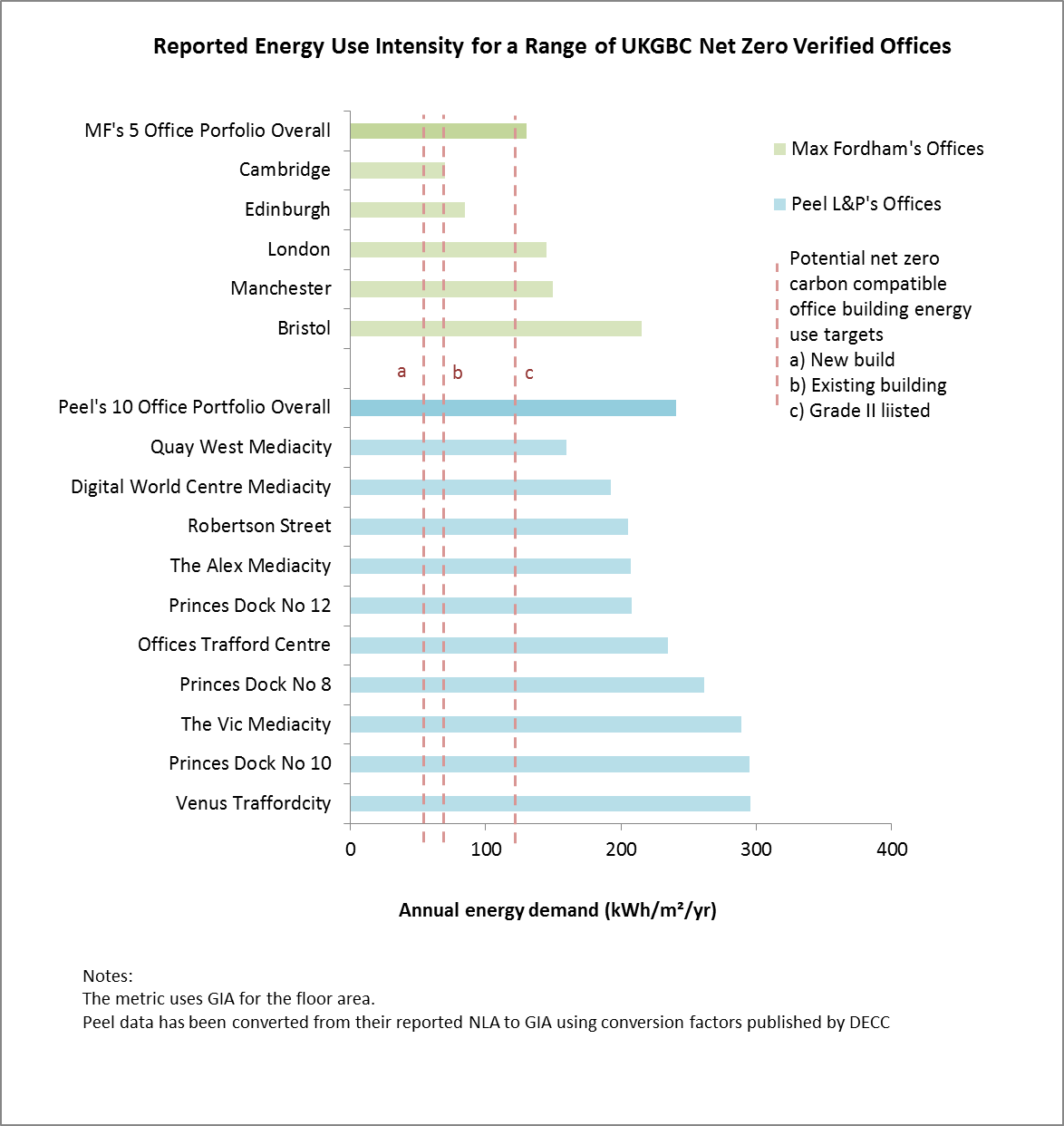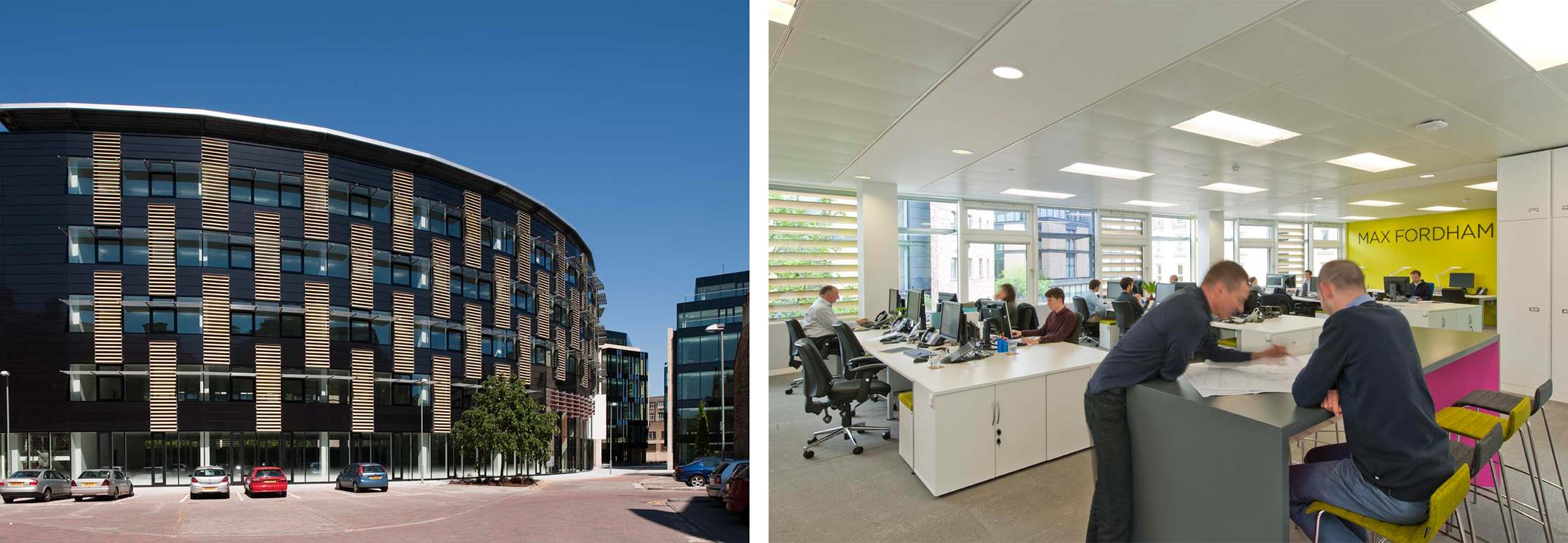Max Fordham – Net Zero Offices
But it’s not enough. How should we deal with existing buildings?
We’re proud to report that our offices have been verified as being net zero carbon (for operational energy related emissions) in accordance with the UKGBC Net Zero Carbon Building Framework1 for the period 2018-2019.
To achieve this, we’ve invested in our offices over the past 10 years to reduce energy demand, improve metering, and we’ve added some renewable electricity generation. We’ve appointed a team of Energy Champions to monitor and manage our energy use, and we’ve purchased carbon credits to offset the remaining CO2 emissions that result from the operation of our five offices.
The work we’ve carried out has put us at the forefront of the net zero carbon revolution, has provided valuable insight into how net zero carbon buildings can be designed and operated, and has been instrumental in further development of the UKGBC Framework.
All this is true and yet we assert that it’s not good enough; in order to end the UK’s contribution to global warming, further effort and a revised strategy for net zero carbon buildings are needed. Not just for our offices, but for all of the buildings in the UK. This article explains why and how.
OUR ROUTE TO NET ZERO (FOR THE TIME BEING…)
The general strategy we used to achieve net zero carbon status for our five offices was:
Reduction of energy use
1. Over the past 10 years we have invested in building improvements to significantly reduce energy demands in the buildings we occupy. Examples include adding roof and wall insulation, adding insulating secondary glazing, upgrading lighting to high efficiency LED fittings, and installing new heating systems. Our Cambridge office is an exemplary case study; our low energy refurbishment improved the energy efficiency standard from an EPC G to and EPC A. Look out for a future MF:Net Zero article on our Cambridge Office Low Energy Refurbishment, where we’ll present the details of how we achieved this.
2. In all of our offices we’ve implemented management procedures to monitor energy and reduce demand. We have a team of Energy Champions who carry this out.
Renewable energy generation
3. We’ve installed a solar photovoltaic panel (PV) array on the roof of our London office.
Measurement of actual energy use
4. We have undertaken comprehensive and detailed meter reading and analysis. In order to facilitate this, we installed more meters where required. For example, we designed and installed a heat metering system in our Edinburgh office to be able to separate our own heat use from that of the rest of the building.
Offset the resulting carbon emissions
5. The meter data analysis showed that our five offices use 120 megawatt hours per year (MWh/yr) of gas and 180 MWh/yr of electricity. Based on these figures the annual carbon emissions were calculated to be 73 tonnes of carbon dioxide equivalent (tCO2e) for the period 2018-2019.
To offset these emissions we purchased carbon credits from a UK woodland creation project. The project is certified by the Woodland Carbon Code to absorb 970 tCO2e over its 60-year lifetime. We decided to purchase multiple times more offsetting than strictly required because we based our offsetting quantity on anticipated cost to society, rather than available sale prices. That is, we made use of published opinion from the Committee for Climate change2 (CCC) that estimates the cost of decarbonising buildings at £100 per tonne of CO2 rather than the available offsetting sale price, which was £7.50 per tonne of CO2. One can think of this as accelerated offsetting. Whilst we think this is an appropriate and responsible action for the short term, we know it’s not a sustainable long-term net zero carbon strategy. Further information on carbon offsetting can be found in our article Carbon Offsetting: Friend or Foe?
ENERGY USE INTENSITY
An essential part of a net zero carbon strategy is limiting the amount of energy buildings need to run. The energy use intensities (energy demand per m2) of our five offices are shown in the chart below:

Energy use intensity for Max Fordham’s five offices
These can be compared with the CIBSE TM46 (DEC D) benchmark of 215 kWh/m2/yr, which is representative of a typical office of the existing UK building stock. Compared to this benchmark, our London office (by far our largest office) shows an improvement of around 30% and our Cambridge office a 70% improvement in energy demand. Overall, our five Office portfolio is measured to have an energy demand around 40% less than the typical office benchmark.
Further details of our Offices’ net zero carbon building strategies, analyses and reporting can be found in our Max Fordham Offices UKGBC Net Zero Carbon Buildings Report. The work has been verified as being in accordance with the UKGBC Framework by a 3rd Party auditor, Etude. Their report can be found here.
In undertaking the work described we feel that we’re acting responsibly at an exemplary level for the time being. However, we assert that it’s not good enough. In order for buildings to be compatible with a net zero carbon future, more work and a different approach is needed. Not just for our offices, but for all the buildings in the UK.
WHY IT’S NOT ENOUGH: A DIFFERENT STRATEGY FOR A NET ZERO FUTURE
The UKGBC Net Zero Carbon Building Framework is a fantastic piece of work. The definitions of net zero carbon buildings and the methods it sets out to achieve them, along with its publication, are a valuable and vital step towards achieving net zero carbon for the UK. We’re using the Framework on several live projects where it is proving to be useful and effective.
However, to be most effective, the Framework needs to be implemented in conjunction with a few other key strategic requirements; namely, setting building energy demand targets, a requirement for low carbon heating systems, and a requirements for the amount of renewable electricity to be generated.
1 SETTING BUILDING ENERGY DEMAND TARGETS
For the UK to achieve net zero carbon, the national energy demand needs to be balanced with the amount of renewable energy capacity; the more energy our buildings use, the more renewable energy is needed in order to meet their demand. However, there is a limit to the amount of renewable energy we can feasibly generate in the UK and energy demand continues to rise. Therefore, plans for a zero carbon future have to include ways to limit the energy demand of buildings.
We urgently need to define and stick to energy demand targets. These targets must be compatible with a net zero carbon future for existing and new buildings, and will enable building owners, tenants and designers to plan for the future.
In general, reasonable progress has been made for new buildings; RIBA3 and LETI4 have both made proposals that the energy demand for new build offices should be in the region of 55kWh/m2/yr (Look out for a future MF:Net Zero article presenting the concept design for an archetypal net zero carbon, new-build office.) However, there is little or no published guidance on net zero carbon compatible energy demand targets for existing buildings5. These are urgently needed. To fill that void we’ve made a start by proposing some targets for offices. These are described below and can be considered as a starting point for discussion.

Current and proposed energy targets for net zero carbon office buildings
We’ve adopted LETI’s proposal that for new build offices the energy use target should be 55kWh/m2/yr. This is before the contribution from on-site renewable electricity generators is considered. In general, it is found that existing buildings are more difficult to treat, in which case it is suspected that it will be more cost effective to meet net zero carbon with a greater amount of renewable energy. So, a slightly less stringent target of 70kWh/m2/yr is suggested for offices within existing buildings.
Heritage buildings in a net zero carbon future
It is proposed that heritage is important and worth preserving. However, heritage listed buildings will be some of the hardest to improve for a net zero carbon future. Therefore, it is proposed that heritage buildings should have less stringent, but still quite ambitious, energy targets than the general building stock. We propose a value of 120 kWh/m2/yr.
There are roughly 600,000 listed and 30,000,000 total buildings in UK, so listed buildings represent around 2% of the entire building stock. That is a small fraction of the total. For many historic listed buildings, the energy target values we’ve proposed will be achievable with moderate improvements to the building fabric and by using heat pumps to meet most of their heating needs. A challenge with this approach is the feasibility of being able to heat poorly performing buildings with heat pumps, because most heat pumps can’t produce as high temperature heating water as gas boilers. That said, given the analysis we’ve carried out on our own London Grade II listed office, we think in many cases it will be possible to heat listed buildings with heat pumps.
Perhaps a more complex issue is the improvement of buildings within conservation areas (that are not listed), simply because there are many more of them. Catherine Bottrill of the Environmental Change Institute estimates that there are 1.2 million homes within conservation areas representing around 4% of the total UK housing stock6. It is not known if using relaxed energy demand targets for this extent of buildings is compatible with a net zero carbon future.
Alternatively, perhaps as a society we may have to accept that certain aspects of heritage should not be conserved (such as uninsulated solid brick walls and single glazing) because they are inherently wasteful of energy and not compatible with a net zero carbon future.
2 LOW CARBON HEATING SYSTEMS
In addition to setting building energy demand targets, another essential requirement for net zero carbon buildings is that they stop using gas and use a low carbon heating system instead. In their Net Zero UK report, the Committee for Climate Change (CCC) state that 100% of non-domestic buildings will need to use low carbon heating systems as part of the net zero strategy for the whole of the UK2.
The CCC identifies two general options for low carbon heating of buildings; electric heat pumps or hydrogen boilers. To be compatible with a net zero future, either of these could be supplemented with a small fraction of direct electric (resistive) heating. In the case of heat pumps, the systems could be supplemented with natural gas boilers for peak loads, if required, with these running for only small amounts of time. This type of heat pump + gas boiler system is known as a hybrid heat pump system. Developments in heat pump technology mean that in many buildings heat pumps can already meet the peak heating demand without the need for backup gas systems.
As hydrogen boilers and infrastructure aren’t currently available, this author’s opinion is that projects pursuing net zero status at the moment should be using heat pumps to meet the majority of their heat loads. Waiting for hydrogen to turn up is not a responsible net zero strategy: this is because in all likelihood the earliest it will be usable for heating is 2050, by which time it may already be too late to keep global warming within recommended targets. However, not everyone shares this view; look out for a future MF:Net Zero article on the case for a hydrogen-heated UK.
3 RENEWABLE ELECTRICITY GENERATION
In addition to introducing building energy demand targets and the requirement for low carbon heating systems, the third aspect of the UKGBC framework that we’ve identified as requiring development is guidance on the optimal amount of renewable electricity to be generated. This topic will be addressed in a future article.
WHAT DOES THIS MEAN FOR ACTUAL BUILDINGS?
A key strength of the UKGBC Net Zero Carbon Building Framework is the requirement for verified buildings to publish their energy use and carbon emissions data. We can learn a lot about the potential routes and challenges to achieving net zero carbon in the UK building stock by analysing this data.
As far as we are aware, at the time of writing this article, only ourselves and Peel L&P7 have achieved UKGBC net zero carbon status; so we’ve analysed all the available data.
ANALYSING DATA FROM THE FIRST NET ZERO CARBON VERIFIED BUILDINGS
The chart below shows the reported energy use intensity from the buildings in the data set. All the buildings are offices. The data shows that in general, our offices use less energy per m2 than Peel’s*. This is probably because all of our offices are naturally ventilated and passively cooled. The data suggests that that much of Peel’s stock may be mechanically ventilated and air conditioned. Or perhaps their buildings are in use for much longer hours than ours, or more densely occupied?
[*Note: We want to make it clear that we’re not criticising Peel or their buildings. Quite the opposite! Peel should be commended for the work they have undertaken on energy efficiency, carbon emission reductions, transparency and reporting. We encourage anyone reading this to follow their example and pursue UKGBC Net Zero Carbon building status as soon as possible.]
In order to reduce the energy demand of our offices to our suggested Existing Building target of 70kWh/m2/yr, we (Max Fordham) would have to reduce our demand across our five-office portfolio by around 50%. Peel would need to reduce their energy demands by around 70% to achieve the same outcome. This has crystallised our view that although our offices have been verified as net zero carbon (this time around, based on the current UKGBC Net Zero Carbon Framework requirements), we will need to further reduce our energy demand to keep on a trajectory towards net zero carbon for the UK.
THE PATH TO A NET ZERO CARBON FUTURE: TWO MAX FORDHAM OFFICE CASE STUDIES
Our Edinburgh Office – a new building

Our Edinburgh office
Our Edinburgh office occupies part of the 1st floor of a 5-storey office. The building was constructed in 2010; our tenancy was refurbished by ourselves in 2015. The building is reported by the landlord to have been designed to a relatively good standard of energy efficiency, exceeding the standards set by Building Regulations that were relevant at the time of design and to have achieved an EPC B+ and BREEAM Excellent rating.
The current measured energy demand of our tenancy is 85kWh/m2/yr, with around 60% of this associated with the heating. If we wanted to achieve the 70kWh/m2/yr existing building standard that we’ve suggested as being compatible with a net zero carbon future, then an option would be to change the gas fired boilers to heat pumps. The building fabric thermal performance is thought to be good enough already. If this is so, then there is a reasonable chance that re-using the existing heating pipework and radiators may be possible even at the lower temperatures provided by heat pumps compared to gas boilers.
However, we’re not in control of the heating system, it is owned and operated by the building landlord, so this type of change could only be carried out by them.
Our London Office – an existing, Grade II listed building

The Rotunda – our London office
Our London office occupies part of a historic Grade II listed building (The Rotunda) in Camden town. The building was constructed in the 1800s. Its current energy use intensity is 145kWh/m2/yr. Despite its listed status and unusual shape8, our London office has construction and energy characteristics that are fairly typical of much of the UK building stock. The building has solid brick walls (without insulation), a pitched, moderately insulated roof and good daylight. The building is almost completely naturally ventilated and passively cooled. The building has (listed) single glazing. To reduce heat energy loads we added interior secondary (single) glazing so that the windows effectively become double glazed. We also added a lobby to reception to reduce heat loss through draughts. In terms of services, we recently installed new boilers and high-efficiency LED lighting, with automatic controls in most places. The majority of energy demand in our London office is for a) staff computers, b) a central data server and its cooling fan, and c) space heating. About half of the total energy demand is related to computer use and not much to do with the actual design of the building. We already attempt to use the most energy efficient computers, so scope for reduction there is limited. We are experimenting with power circuits that automatically switch off during certain hours to avoid wasting energy if someone forgets to turn their computer off.
Meeting energy demand targets for a Grade II listed building
If you are of the opinion that historic listed buildings should have less stringent energy targets than the general stock in a net zero carbon future, then you might consider the 120kWh/m2/yr target as suitable. In which case, for our London office, this would require reducing energy demands by 20% from the current situation. We could probably come close to achieving this by simply changing to a cloud-based server. However, this might just move the energy demand and carbon emissions from one place to another. Whether or not cloud based servers are less energy intensive than office-based systems is something we’ll have to investigate. The fact that around 20% of our office’s energy demand is for IT servers shows that low energy data systems are an essential part of a net zero carbon future.
Rather than changing the servers, an option (to reduce energy demand in our London office by about 20%) would be to add heat pumps for space heating. Due to the un-insulated brick walls, heat loss is not quite as low as we’d like it to be so we’d probably need to keep our gas boiler too for use on a few cold days a year. A further option for 20% energy reduction would be to insulate all of the walls (internally or externally) and keep using our gas boilers, however, this is likely to be much more expensive than using heat pumps and doesn’t make use of a low carbon heating system.
Meeting energy demand targets for a general (non-listed) existing building
If you’re of the opinion that historic listed status should be ditched in favour of energy efficiency and reduction in carbon emissions, then we’d be looking to reduce energy demand to around 70kWh/m2/yr; a 50% reduction from the current situation. This could be done by wrapping the whole building in 300mm of external wall insulation, with a new weather-proof outer façade layer; that is, covering up history to provide a new aesthetic. We’d also need to replace (or append to) the single glazed windows with sealed triple glazed units. We’d pressure test the building to high standards of air tightness and add mechanical ventilation with heat recovery (MVHR). In addition to this we’d need to use heat pumps for heating (and possibly hot water too) without gas boiler top-up. This would bring the heat energy demand down to about zero, with heat from people and computers warming the space. The total energy demand would be around 90kWh/m2/yr, which is still not low enough. To get down to the aspired 70kWh/m2/yr, we’d also need to upgrade about 30% of our light fittings to the highest efficiency LED fittings (70% of them are already very good) and implement some method to reduce server energy demand.
An alternative option that wouldn’t affect the external (listed) facade would be to insulate the walls internally, rather than externally, but it wouldn’t yield quite as good energy savings due to unavoidable cold bridges.In addition to cost, a further challenge when carrying out the types of work described is the fact that we are tenants, not owners. We’d need to carry out the work with the permission of, and in conjunction with, our landlord.
CONCLUSION
Our offices are some of the first to be verified as being net zero carbon in accordance with the UKGBC Net Zero Carbon Building Framework (for operational energy related emissions). To achieve this, we’ve invested in both architectural and building services energy efficiency improvements, installed some renewable electricity generation and we’ve purchased carbon offsetting to reach a net zero annual carbon emission balance. In the case of our Cambridge office, we’ve designed and implemented a very low energy refurbishment that has measured annual energy demands 70% less than those of a typical existing office. In our London office, which is by far our largest building, we’ve designed and implemented improvements such as roof insulation, secondary glazing, high efficiency lighting, new heating systems and a roof-mounted solar PV array. Our overall five office portfolio has a similar energy demand performance to our London office with an annual energy use intensity of around 140kWh/m2/yr: 35% less than that of a typical existing office.
We’re proud to have achieved the net zero carbon status and believe that we are leading the field with respect to the route to net zero. The work we’ve carried out has provided valuable insight into how net zero carbon buildings can be designed and operated, and has been instrumental in further development of the UKGBC Framework. Whilst this is true, at the same time we assert that the net zero strategies used on our own offices are not enough for a net zero carbon future. For most of our offices, building energy demands could be considered too high, gas boilers rather than low carbon heating systems are in use, and the extent of renewable energy is not enough. This isn’t just the case for our offices, it is true for (very nearly) all the buildings in the UK, therefore a different strategy is needed.
To make the most of the UKGBC Net Zero Carbon Building Framework and to deliver buildings that are compatible with a net zero carbon future it needs to be used in conjunction with three other key requirements;
- Setting building energy demand targets,
- low carbon heating systems, and
- a sufficient amount of renewable electricity.
With regards to building energy demand, we’ve suggested some targets for offices. These are proposed to be net zero carbon compatible. Consistent with RIBA and LETI, for new build offices we’ve suggested 55 kWh/m2/yr. Whilst this is helpful, guidance relating to existing buildings is currently lacking and urgently needed; we’ve filled this void by proposing some. For general existing offices we’ve suggested 70 kWh/m2/yr. (The UKGBC have recently published similar targets9. These will be examined and discussed in a forthcoming MF:Net Zero article). Since three of our five offices are within Grade II listed buildings, we’ve considered this situation too. We’ve suggested that less stringent (but still ambitious) standards could be appropriate for listed buildings. For offices within Grade II listed building we’ve suggested a target of 120 kWh/m2/yr.
We’ve looked at two existing office building case studies, one new and one old. Our Edinburgh office tenancy sits within a fairly modern building, while our London office is within a historic Grade II listed building. To reduce our Edinburgh office’s energy demand to the proposed target of 70 kWh/m2/yr we have estimated that changing the heating system from a gas boiler to a heat pump system. Our London office is more complicated, so a strategy to approach this energy target would be far more complex and expensive, including adding mechanical ventilation with heat recovery (MVHR).
Some argue that attempting to add insulation and MVHR to all the existing buildings in Britain will be too difficult and expensive due to socio-political barriers. If this is accepted, then the solution for a net zero carbon UK will need to accept that reducing existing building energy demands to very low values is not possible and net zero would need to be achieved by the generation of large quantities of renewable (or nuclear) power instead.
Whatever the routes to net zero carbon, more action is needed. From businesses, households, organisations and individuals. More importantly, more action is urgently needed from central Government in the form of support and legislation; carrot and stick.
We’re currently exploring options and developing 10-year net zero carbon strategies for our London office and for a range of client projects. If you want or need a net zero carbon strategy for your project, then please do get in touch and we can talk about it.
We’d like to thank our Net Zero Carbon auditor Etude for their contributions. You can read their opinions on what net zero carbon should be in their audit report.
We’d like to commend and thank Peel L&P for being the first to achieve UKGBC net zero carbon status10 and making their building data available7.
Footnotes and references:
1https://www.ukgbc.org/ukgbc-work/net-zero-carbon-buildings-a-framework-definition/
2https://www.theccc.org.uk/wp-content/uploads/2019/05/Net-Zero-The-UKs-contribution-to-stopping-global-warming.pdf (Chapter 7)
3https://www.architecture.com/-/media/files/Climate-action/RIBA-2030-Climate-Challenge.pdf
4London Energy Transformation Initiative Net Zero 1 Pager: https://b80d7a04-1c28-45e2-b904-e0715cface93.filesusr.com/ugd/252d09_d2401094168a4ee5af86b147b61df50e.pdf
5In fact, since this article was written, the UKGBC have developed the Net Zero Carbon Building Framework to include energy demand targets for offices. The details can be found here: https://www.ukgbc.org/wp-content/uploads/2020/01/UKGBC-Net-Zero-Carbon-Energy-Performance-Targets-for-Offices.pdf. However, the energy metric they’ve chosen isn’t directly comparable to the work produced by RIBA, LETI or described here. Look out for a future MF Net Zero article discussing the details and implications of the UKGBC Net Zero Carbon: energy performance targets for offices.
6https://www.eci.ox.ac.uk/research/energy/downloads/40house/background_doc_K.pdf
7https://peellandp.co.uk/responsibility/
8The Rotunda’s plan is an icosidigon (or icosikaidigon), a 22 sided shape.




